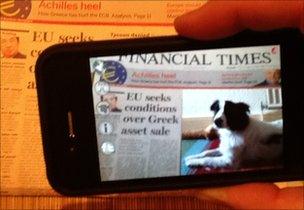Aurasma: Augmented reality future or forgettable fun?
- Published
- comments
Rory Cellan-Jones tests augmented reality software that plays video over live images filmed through a phone
JK Rowling saw all this coming, said the man who had just shown me a newspaper where the photos moved and talked, straight out of Harry Potter.
And yes, the application which Autonomy's Mike Lynch had demonstrated to make that happen was magical. But what I'm still not quite clear about is whether Aurasma is, as he claims, the idea that makes augmented reality go mainstream.
The app uses Autonomy's high-powered search technology - hitherto just aimed at commercial clients - to link all sorts of things it sees through a smartphones camera to other objects.
So point your phones camera at a poster for the movie Thor - and it will suddenly start playing a trailer.
Hover over the masthead of The Times or The Sun or the Daily Telegraph - and the words start to jump around, before merging into some video.
And show your camera the London Underground symbol and a cartoon starts to play with an athletics commentary, promoting the Tube as the way to get to the London Olympics.
Constructed reality
This is not working via barcodes or NFC technology but through visual recognition. Aurasma is building up a bank of images which it recognises, and sees as a cue to play the video or animate the graphic. It works not just with images on a page but with buildings, landscapes, and soon, we're promised, with people.

Fun, but will it hold people's attention?
Mike Lynch says two advances in the last few years have made this possible. On the device side, the power of the devices is staggeringly unbelievable, and then equally amazing on the algorithm side there've been some very clever mathematical shortcuts discovered which lighten the computational load.
And what's really clever is that Aurasma allows anyone who downloads the app to create their own augmented reality content.
So you choose the image you want to augment, link it to another image or video, and upload what Autonomy calls an Aura to its servers. I tried this, putting a photo of my dog on the front page of the Financial Times, and video of myself on the front of Television Centre. Enormously pleasing, although you might struggle to see the point.
And there's the question - what's this for? Autonomy has never had a consumer product before, and it shows in the way the app is presented.
Once you've got the hang of it, cutting through the jargon of Auras, Happenings and Anywheres - the different classes of objects you create - then it is impressive. But while it does a whole lot more than other augmented reality apps, it still looks like something you might try out a couple of times, then forget.
But the primary audience is not consumers but companies. Aurasma is a free, open platform on which, according to Mike Lynch, all sorts of businesses will build all kinds of applications.
Talking heads
You're standing at a bus-stop, the adverts come to life, you're looking at menu, you can see the food, instruction manuals can show you how to put the Ikea table together.

The app is currently only available on the iPhone 4
Already, newspapers are talking about turning display adverts into video ads - which can earn them more. And movie studios are planning sightseeing tours where you see parts of a film played out in the real world.
Its a vision of a future where images, not words, become the building blocks by which we search the world and understand our surroundings.
But however keen businesses might be to exploit this technology, they will still need consumers to take an interest. Just because something is possible, it doesn't mean that we will want it.
For all its fabulous technology, has Autonomy really looked inside the minds of mobile consumers? And if it did, might it find that we don't want to walk down the streets pointing our smartphone cameras at everything around us?
Still, you might want to have a play with this new technology and give me your verdict.
If so, here's a little experiment, for anyone with an iPhone 4 who wants to try out Aurasma (The app will be coming to Android phones soon, but isn't there yet) cut and paste this link, external and send it to your phone.
Then make sure you are on the front page of my blog and point your camera at my picture. Let me know if it works...
- Published22 December 2010
- Published2 May 2011